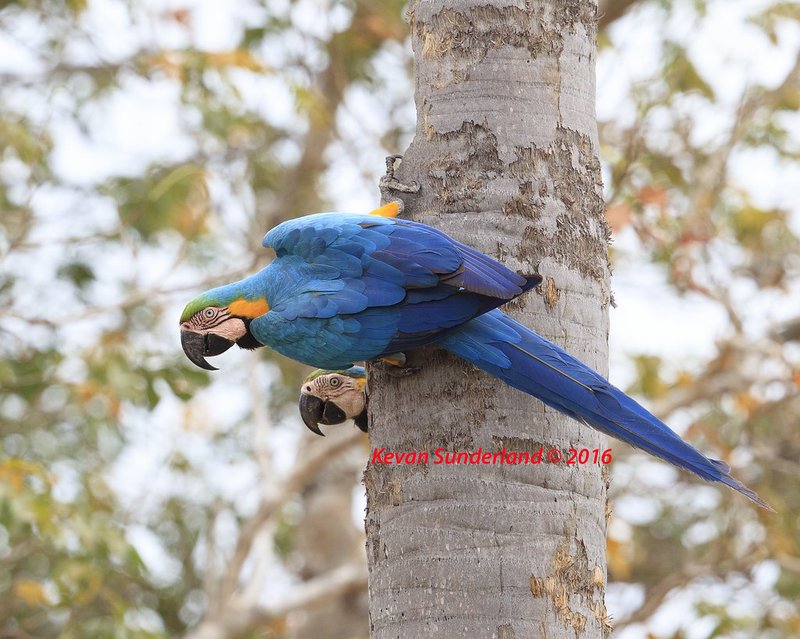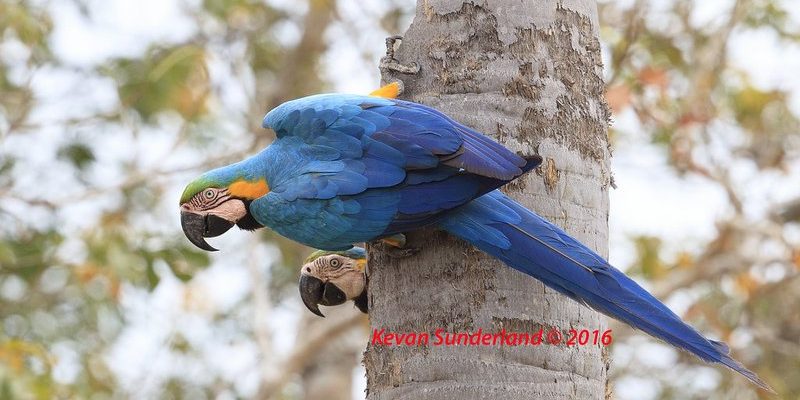
So, how do these magnificent creatures go about raising their young? What are the stages of their lives, from hatchling to adulthood? Let’s dive into the world of blue-and-yellow macaws and explore their nesting habits and lifecycle. Grab your favorite beverage, sit back, and let’s get into it!
Where Do Blue-And-Yellow Macaws Nest?
Blue-and-yellow macaws tend to be quite choosy about their nesting spots. They generally choose large, hollow trees in tropical and subtropical forests. These trees are often tall, providing safety from predators, and have a sturdy trunk to support their nests. You might picture them like a cozy apartment high up — well, that’s exactly what they’re after!
Most often, these birds prefer to nest in old, decaying trees, which offer a natural cavity for their nests. This is a crucial factor for their nesting habits. In the wild, they might use trees like kapok or palm trees since these provide ample space and the right conditions for their young. Honestly, it’s not just about comfort; it’s about safety and a good view.
The nesting site is usually located in the upper parts of the tree, away from ground-level threats. Imagine a little family living high up, safe from curious cats or other ground predators. This way, the parents can keep a close eye on their little ones while also having easy access to food sources below.
How Do Blue-And-Yellow Macaws Build Nests?
When it comes to nest building, blue-and-yellow macaws are rather low-key. They don’t actually construct intricate nests like some other birds. Instead, they take advantage of existing holes in trees. You might think of them as renters rather than builders.
Once they find a suitable cavity, the macaws will line the interior with a few soft materials. This might include feathers, leaves, or even bits of bark. Their nests are quite minimalistic but effective. The parents aim to create a comfortable environment for their eggs and chicks, keeping them warm and protected.
Most importantly, the macaw parents are very selective about which cavity they choose to use. They want to ensure it’s safe from threats while still being easily accessible. You might be wondering why they don’t just build a nest from scratch. Well, the natural cavities serve a dual purpose: they save time and provide a ready-made shelter that has already stood the test of time.
The Breeding Cycle of Blue-And-Yellow Macaws
The breeding cycle of blue-and-yellow macaws typically begins when they reach sexual maturity, which is around 2 to 4 years old. This period is critical for their development, as they’ll spend their early years learning important skills from their parents.
Once they’re ready to breed, usually during the rainy season, they’ll engage in elaborate courtship rituals. These can include vocalizations, flapping, and even playful antics — basically, they’re wooing each other! After they’ve found their mate, they’ll often stay together for life, forming a strong bond.
When it’s time to lay eggs, the female will usually lay 2 to 4 eggs. These eggs are approximately 2 inches long, and both parents take turns incubating them for about 25 to 30 days. While the incubation period is a shared responsibility, the male often hunts for food to ensure the female has enough energy to keep the eggs warm. It’s like a well-organized team effort!
What Happens After Hatching?
Once the eggs hatch, the little blue-and-yellow macaws are altricial, which means they’re born helpless and require a lot of care. The chicks are initially covered in down feathers and rely entirely on their parents for food and warmth. It’s easy to imagine how these tiny, fluffy creatures attract instant attention and care from their devoted parents.
During the first few weeks, the parents will feed the chicks regurgitated food — think of it as a first meal served with extra love. As the days go by, the chicks will begin to grow, and you’ll notice them developing their feathers. Their vibrant blue and yellow colors are a sight to behold as they start to take shape.
After about 3 months, the youngsters will fledge, meaning they’ll learn to fly. However, they won’t be ready to leave their parents just yet. They often stay with them for several more months, learning how to find food and navigate their surroundings. It’s like a graduation process where they gradually gain independence while still benefiting from their parents’ experience and guidance.
Challenges in the Lifecycle of Blue-And-Yellow Macaws
Despite their beautiful appearances, blue-and-yellow macaws face a variety of challenges throughout their lifecycle. Habitat loss is one of the biggest threats, as deforestation and human encroachment have severely restricted their natural living spaces. Without the right trees to nest in, these birds struggle to find safe places to raise their young.
Another issue is the pet trade. Many of these birds are captured for the exotic pet market, which puts additional pressure on their populations. Here’s the thing: capturing them disrupts their natural breeding and nesting habits, leading to fewer macaws in the wild. It’s a real shame since these birds are not only stunning but also play a vital role in their ecosystems.
Predation is another concern, especially for young chicks that are vulnerable during their earliest stages. From snakes to larger birds of prey, the threats are real. This natural competition and danger can significantly impact the success rate of fledglings leaving the nest. It’s a tough life out there, even for these colorful creatures.
Conservation Efforts for Blue-And-Yellow Macaws
Given the challenges blue-and-yellow macaws face, various conservation efforts are underway to help protect them. Organizations are actively working to preserve their habitats by promoting sustainable forestry practices. These initiatives aim to keep the forest ecosystems intact, ensuring that macaws have the trees they need to thrive.
In addition to habitat protection, some programs focus on the rehabilitation of captured birds. These rescues help to rehabilitate macaws taken from the wild and educate the public about the importance of keeping them in their natural habitats. Education is a powerful tool. By raising awareness, these organizations hope to reduce the demand for macaws in the pet trade.
Finally, there are breeding programs aimed at increasing the population in captivity to eventually reintroduce these magnificent birds into the wild. Each successful breeding and release means a chance for these macaws to reclaim their rightful place in the forests of Central and South America. It’s all about giving them a fighting chance in a rapidly changing world.
The Fascinating Life of Blue-And-Yellow Macaws
Blue-and-yellow macaws truly embody the beauty and complexity of nature. Their nesting habits and lifecycle reveal just how intricate and delicate the balance is that keeps their populations thriving. From their selective nesting choices to their dedicated parenting, these birds showcase a remarkable resilience among the challenges they face.
As you ponder the next time you see a macaw, remember the journey that each one takes from a tiny, helpless chick to a magnificent adult. Whether through conservation efforts or simply appreciating their beauty in the wild, we can all play a part in ensuring these beautiful birds continue to thrive for generations to come.
So, the next time you hear a macaw squawking in the distance, take a moment to appreciate all the effort that goes into their magnificent lives. Just like us, they’re navigating their world, and their journey reminds us of the beauty of nature.

